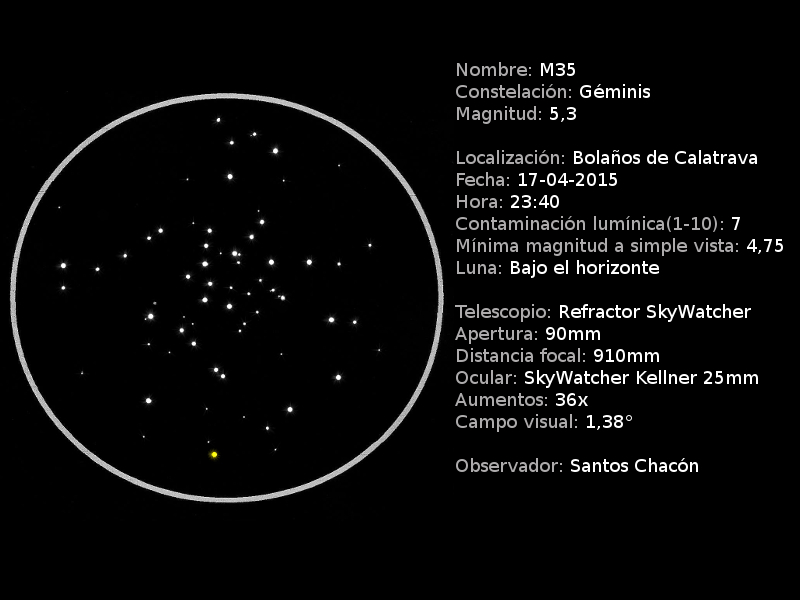
Object Name: M35
Object Type: Open Cluster
Location: Bolaños de Calatrava, Spain
Date: 17-05-2015
Media: graphite pencil, white paper, digital tools.
Telescope: SkyWatcher Evostar 90/900
Eyepiece: SkyWatcher Kellner 25mm
Seeing: 3
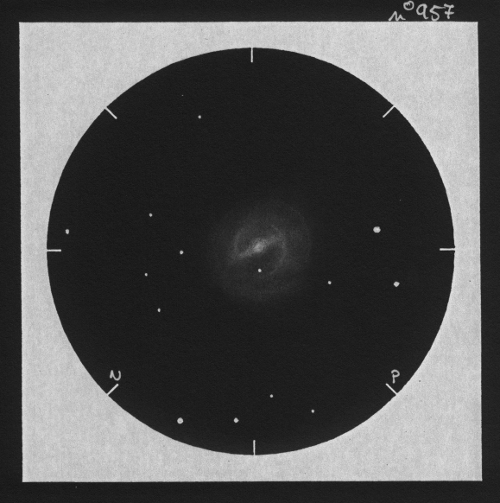
Hi ASOD,
Please find hereby a recent sketch of the barred spiral galaxy M109 in Ursa Major, made during our astro-holiday in Northern France about a month ago. That night the sky completely cleared out with impressive SQM values around 21.6 – being amongst the highest possible in light-polluted Western Europe.
One of the objects scheduled to revisit was Messier 109, since it contains a complex barred spiral structure that is difficult to visually discern. Attentive averted vision under a dark sky though brings out these beautiful features!
Sketch details:
Location: 18 April 2015 – 23h54 UT – Grandpré (Fr)
Conditions: NELM 6.6 – SQM-L 21.6 – Seeing moderate
Optics: SCT C11 (279mm f/10) – Nagler 13mm (215x – FOV 23 arcm) – no filters
Media: graphite pencil on white paper, scanned & inverted using GIMP2
Notes:
Large diffuse face-on galaxy, displays a bright core containing a diagonal barred structure through a round, mottled glow. Attentive averted vision brings out a subtle theta-like structure, less intense at the eastern side and more pronounced on the northwest and southern outer side. The inside of the barred spiral, to the eastside of the core, appears more dark and contains a nice faint field star.
Additional observations of that night can be found in the deepsky database www.deepskylog.org
Clear nights !
Tom

Object Name: Copernicus Crater
Object Type: Lunar Crater
Location: Ottawa, ON, Canada
Date: 2 May 15
Media: Vine charcoal background, graphite pencil for the crater
I am very new at sketching, this being the first one I’d consider worthy of uploading. It was drawn from a photo of Copernicus crater I brought up on my computer screen as practice for the sketching course I’m currently taking. I’m still struggling to convey a sense of depth, as well as develop a rapid technique that I will need when I am at the eyepiece of my telescope.
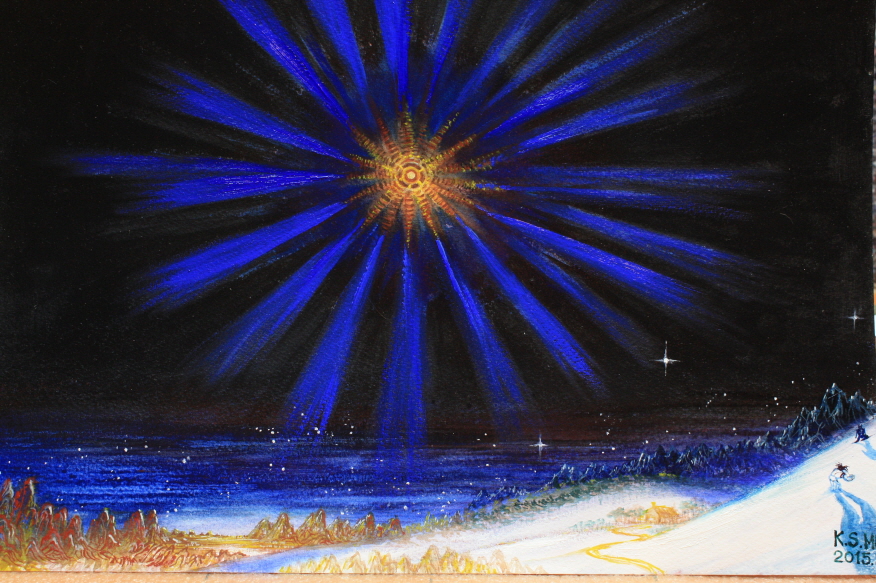
The Zuben-eschamali…. a old beautifuly Arabian-named emerald greenish blue star was lonely shineing that May night just a year ago when l firstly aimed fixed star with freshly constructed 13″ refractor at the highest power which can bears. For more than 2 decade l usealy like to see the fixed single stars of 3-0 mignitude range especially since from the time my 8″, 8.5″ glasses were used
and l looked Vega, Arcturus, Sirius, Capella, Alteir, or 2-3 mignitude stars like this one through 12,13″ glasses particularly at high power 950-1500x . l represented the Zubeneschmali as possible as l can do as you see here but the real thing was far from my humble art for in the 1480 magnification Nagler 2.5s window image l can explain nothing but it was eradiating beautifuly & magnificently, even l felt eerie emotions with the large but still sharpest star image ragely gushed out spokes of light bunches. To explain the 2.6 mag, 160 ly distant alien sun, l made some 20 pages eyepiece sketches with explanationes & l introduce here only one on the recent night Arcturus record as almost 2-0 mag suns to be looked similaly except colors , l named myself the 3 parts at the 1000-1480x images ( under 1000x the 3 parts could not be seen easily with its break downed parts ) as a Diffraction disk part(Airy disk) , 1st flames part , Spokes part …. one 1st flame exactly confrontations one spoke each other & total number of this star,s spokes was observed of 18-25 bunches at every 1/30 second because ca 3-4 rowes of radial spokes rotating each other in slight different directions that l could not represent it here for the spokes were so dynamic as each 3-4 rows spokes rotated once in a 1/50-1/30 seconds that may lie in a human eye,s limited captureing time spans so there l could observe the perspective among the 3-4 rows….
For the other explanations l have to omit as thousends words not equals to just you look through once.
With these observations of years l could more &more feel the fixed stars are alien suns like ours in not fictions (in papers or photos) but in reality, reality emotion… that l feel only just a few minutes for in a full one year,s automatic robotic diary life time span , stangely , in my private opinion , we humanbeing (include other species on earth?) have not yet the 7th sensor organ feel direct the existent emotions in cosmos.
l have to thanks for the pioneers who firstly sought the star parallaxes.
My humble instruments are imposing enough against the 5 billion doller HST at least when they aim fixed stars , if l seated in it with 15,000x power, it,ll show me nothing but a 1/10 diameter Airy disk of mine even the HST can,t show the Alien sun,s limb circle even in pinpoint size at all that tells the vastness of the interstellar space.
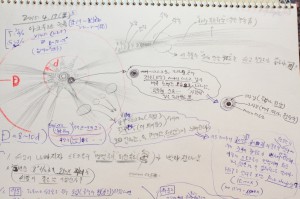
K.S. Min
Observed; 2014. 5
Painted ; 2015. 5
320mm refractor x1480
Graphite pencils, water color, acrylic& oil color, white paper 30x45cm (working time; 4 hours)
Himax follows the Blackmax climing snowy hills where on a old Taoism landscaped alien planet in the Zubeneschamalli solar system
Photographed in a room w/ lights with a Canon 450d camera
South Korea

Hi,
This sketch of my favorite planet of the solar system, that day their moons aligned, the great red spot and below this, the shadow of Europe, the picture was very rewarding and enjoyed meeting observation, but since the city only allows this type comments, try to have a place for these events really impressive. The original sketch was reduced and adjusted as is the eyepiece.
Best regards.
Roberto.
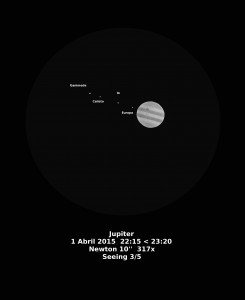
Object name: Jupiter
Object type: Planet
Location: Madrid City ( Spain )
Date: 1 April 2015
Hour: 22:15 < 23:20
Media: Graphite pencil, processed and inverted gimp 2.8
Optical equipment: Dobsonian telescope 10'' F/5 Eye piece Ethos 8mm + Barlow 2x
Magnification 317x
Sky conditions: Seeing 3/5.
http://dibujodelcielonocturno.blogspot.com.es/
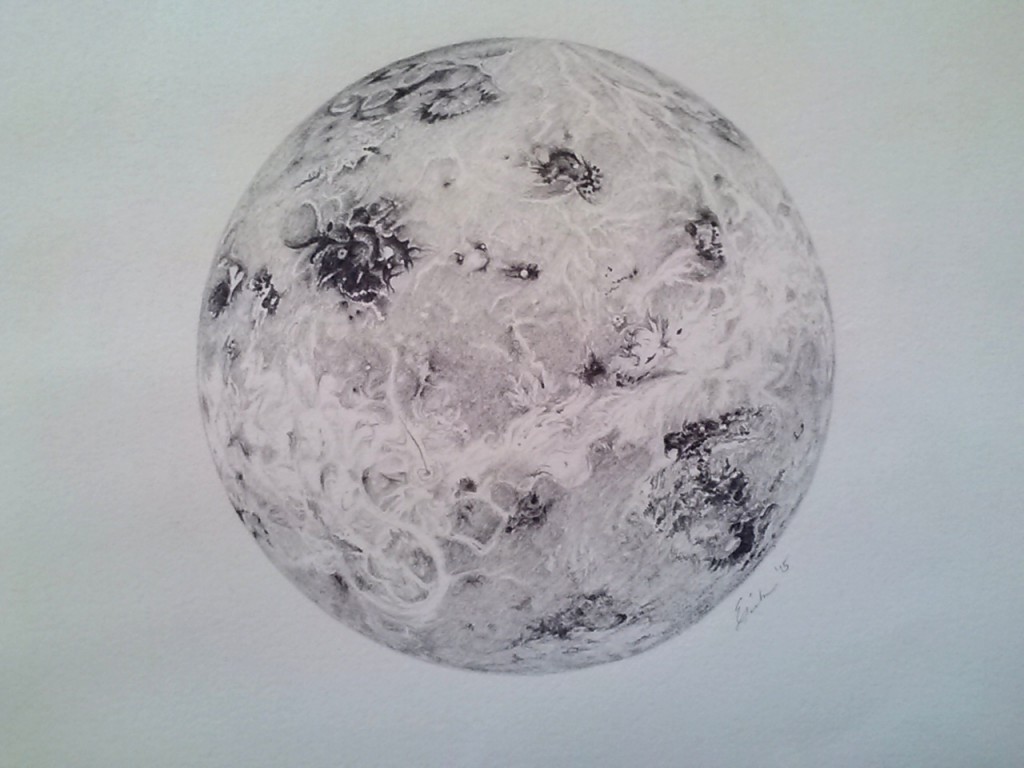
I have a new submission for you. I have been working on this series of our solar system for some time now and plan to complete it someday. Each one has been a labor of love.
Object Name Venus
Object Type Planet
Location studio
Date completed 4/1/15
Media graphite on archival paper
Thank you!
Erika McGinnis
www.erikamcginnisart.com
visit me on Facebook: www.facebook.com/erika.mcginnis.1
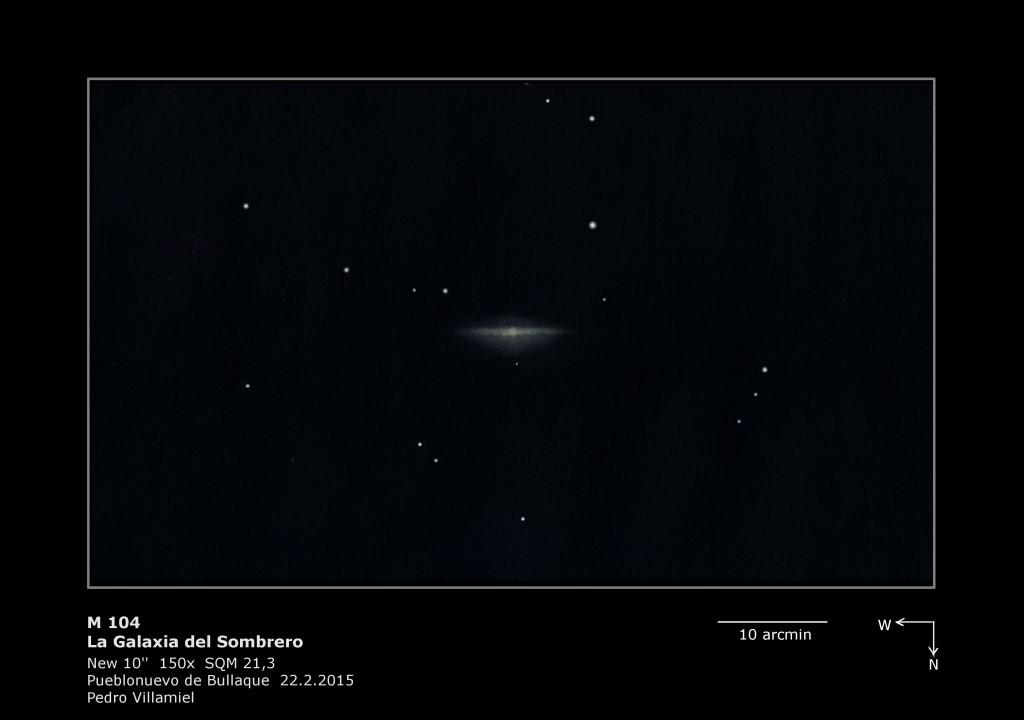
• Object Name: Messier 104 – The Sombrero Galaxy
• Object Type: Spiral galaxy
• Location: Pueblonuevo del Bullaque – Spain
• Date: 2015.2.22
• Media: Graphite Pencil HB 2, torchon 1 and 130g drawing sheet
• Inverted color and stars with GIMP 2.8
Observation notes:
Los objetos más importantes se les suele echar un vistazo siempre que están a nuestro alcance, pero las sensaciones son siempre distintas en cada observación. Antes de esta observación y no sé porque, esta notable galaxia, nunca me había llamado la atención.
The most important objects are often look so long as they are within our reach, but the feelings are always different in each observation. Before this observation and not know why, this remarkable galaxy, never caught my attention.
Greetings to all visitors of this page.
Pedro Villamiel
Alcorcon, Madrid 20.02.2015
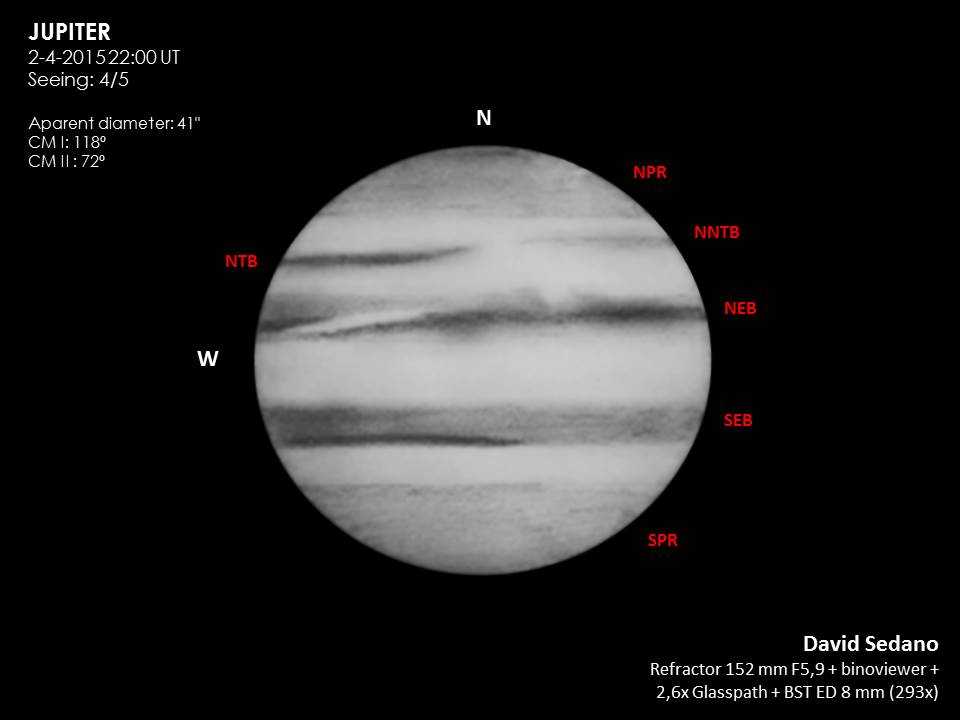
Object Name: Jupiter
Object Type: planet
Location: Penalver (Spain)
Date: 3-4-2015
Media: graphite pencil on white paper, captured with digital camera and processed with Gimp.
Hi This is a sketch of the planet Jupiter made throught my 6” achromatic refractor (TS Individual 152/900), binoviewer, a pair of 8 mm eyepieces and glasspath that gave me 293x. The seeing was very good during all the observation, allthought the arriving of high clouds at 01:00 am ended with the fun.
It was remarcable the wedge that seems to divide the NEB and a bright patch between this belt and NTB that reminds a great oval.
I hope you to enjoy with this sketch.
If you wish to read more about this observational report and others, please visit the web of my astronomical group (www.laotramitad.org).
Best regards.
David Sedano